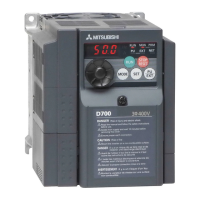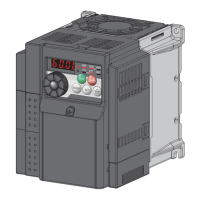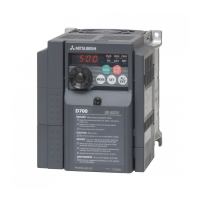What does PU stop mean on Mitsubishi Electric Inverter?
- Jjessica23Sep 3, 2025
Stop with of the PU is set in Pr. 75 Reset selection/disconnected PU detection/PU stop selection. Turn the start signal OFF and release with .

What does PU stop mean on Mitsubishi Electric Inverter?
Stop with of the PU is set in Pr. 75 Reset selection/disconnected PU detection/PU stop selection. Turn the start signal OFF and release with .
| Model | FR-D720-0.4K |
|---|---|
| Series | FR-D700 |
| Rated Output Capacity (kVA) | 0.8 |
| Output Rated Current (A) | 2.5 |
| Input Voltage | 200-240VAC |
| Input Phase | 3-phase |
| Horsepower | 0.5 HP |
| kW | 0.4 kW |
| Input Frequency | 50/60Hz |
| Cooling Method | Fan cooled |
| Humidity | 90% RH or less (non-condensing) |
| Output Voltage | 3-phase 200-240V AC |
| Output Frequency | 0.2 to 400 Hz |
| Control Method | V/F control, vector control |
| Frequency Range | 0.2 to 400 Hz |
| Protection Features | Overcurrent, Overvoltage, Short Circuit |
| Operating Temperature | -10°C to +50°C |
| Storage Temperature | -20°C to +65°C |
| Altitude | 1000m or less |
Verifies the inverter model and accessories against the order and ensures the product is intact.
Details the various peripheral devices that can be connected to the inverter for expanded functionality.
Provides instructions for safely removing and reinstalling the front and wiring covers for access.
Covers environmental requirements and design considerations for inverter installation enclosures.
Explains the terminal connection diagrams for main and control circuits, including options.
Details the specifications for main circuit terminals, including power input and motor wiring.
Defines specifications for control circuit terminals, including input, output, and communication signals.
Guides the connection of optional units like brake resistors, brake units, and reactors.
Addresses measures to reduce electromagnetic noise and handle leakage currents to prevent malfunctions.
Explains the necessity and procedure for installing reactors to prevent issues caused by power input circuits.
Recommends using magnetic contactors on the inverter's input side for safety and maintenance purposes.
Details measures for driving 400V class motors to prevent insulation deterioration due to surge voltages.
Provides essential guidelines to prevent product damage or shortened lifespan from incorrect handling.
Explains system configurations and interlocks to prevent accidents even if the inverter fails.
Describes the names and functions of the operation panel components for controlling the inverter.
Lists all available parameters, their settings, initial values, and related pages for reference.
Details how to adjust torque boost and other parameters to optimize motor performance.
Explains how to set maximum/minimum frequencies and avoid mechanical resonance points.
Describes setting base frequency, voltage, and load patterns for optimal V/F characteristics.
Covers multi-speed operation, jog operation, and remote setting functions using external terminals.
Details how to set acceleration, deceleration times, and patterns for smooth motor control.
Covers motor overheat protection and selection of appropriate motors for optimal performance.
Explains DC injection braking, regenerative braking, and various stop selection methods.
Details how to assign functions to input and output terminals for various control signals.
Describes how to select and display various operating status and monitor signals.
Covers automatic restart and power-failure deceleration stop functions for system continuity.
Explains retry functions and phase loss protection for managing fault conditions.
Details optimum excitation control to improve motor efficiency and achieve energy savings.
Provides techniques for reducing motor noise, EMI, and avoiding mechanical resonance.
Explains how to use analog signals for frequency setting, including bias and gain adjustment.
Covers functions like PU stop, parameter write disable, and password protection.
Details how to select operation modes (PU, External, Network) and control sources.
Explains PU connector wiring, RS-485 communication, and Modbus-RTU specifications.
Covers advanced functions like PID control, dancer control, and regeneration avoidance.
Describes functions such as cooling fan control, part life display, and maintenance timer alarm.
Details operations for setting parameters, changing display language, and adjusting panel contrast.
Explains how to connect and configure the FR-E500 series operation panel.
Provides instructions for clearing parameters to their initial values or clearing all parameters.
Allows viewing and setting parameters that have been changed from their initial values.
Explains how to check and clear the inverter's fault history records for diagnostics.
Describes the procedures for resetting protective functions after a fault occurs.
Provides a comprehensive list of fault and alarm codes displayed by the inverter.
Details common causes for error messages, warnings, and faults with their respective corrective actions.
Lists the mappings between digital codes and actual alphanumeric characters shown on the operation panel.
Offers initial checks and troubleshooting steps for common motor and machine issues.
Covers daily and periodic inspection procedures to prevent faults and ensure reliable operation.
Details how to measure main circuit electrical parameters using various instruments.
Presents the electrical ratings and specifications for different inverter models and power supplies.
Lists general specifications including control methods, frequency range, and input/output signals.
Provides detailed mechanical dimensions and panel cutouts for various inverter models.












